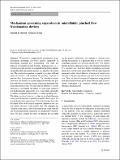Mechanism governing separation in microfluidic pinched flow fractionation devices
Author(s)
Risbud, Sumedh R.; Drazer, German
Download10404_2014_Article_1404.pdf (435.6Kb)
PUBLISHER_POLICY
Publisher Policy
Article is made available in accordance with the publisher's policy and may be subject to US copyright law. Please refer to the publisher's site for terms of use.
Terms of use
Metadata
Show full item recordAbstract
We present a computational investigation of the mechanism governing size-based particle separation in microfluidic pinched flow fractionation. We study the behavior of particles moving through a pinching gap (i.e., a constriction in the aperture of a channel) in the Stokes regime (negligible fluid and particle inertia) as a function of particle size. The constriction aperture is created by a plane wall and spherical obstacle, and emulates the pinching segment in pinched flow fractionation devices. The simulation results show that the distance of closest approach between the particle and obstacle surfaces (along a trajectory) decreases with increasing particle size. We then use the distance of closest approach to investigate the effect of short-range repulsive non-hydrodynamic interactions (e.g., solid-solid contact due to surface roughness, electrostatic, or steric repulsion, etc.). We define a critical trajectory as the one in which the minimum particle–obstacle separation is equal to the range of the non-hydrodynamic interactions. The results further show that the initial offset of the critical trajectory (defined as the critical offset) increases with particle size. We interpret the variation of the critical offset with particle size as the basis for size-based microfluidic separation in pinched flow fractionation. We also compare the effect of different driving fields on the particle trajectories; we simulate a constant force driving the particles in a quiescent fluid as well as a freely suspended particles in a pressure-driven flow. We observe that the particles approach closer to the obstacle when driven by a constant force, than those freely suspended in a pressure driven flow (for the same initial offset). On the other hand, the increment in the critical offset (as a function of particle size) is larger in the pressure-driven case than in the force-driven case. Thus, pressure-driven particle separation using pinched flow fractionation would prove more effective than its force-driven counterpart (e.g., particles settling under gravity through a pinching gap).
Date issued
2014-05Department
Massachusetts Institute of Technology. Department of Chemical EngineeringJournal
Microfluidics and Nanofluidics
Publisher
Springer Berlin Heidelberg
Citation
Risbud, Sumedh R., and German Drazer. “Mechanism Governing Separation in Microfluidic Pinched Flow Fractionation Devices.” Microfluidics and Nanofluidics 17.6 (2014): 1003–1009.
Version: Author's final manuscript
ISSN
1613-4982
1613-4990